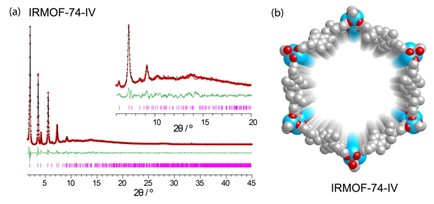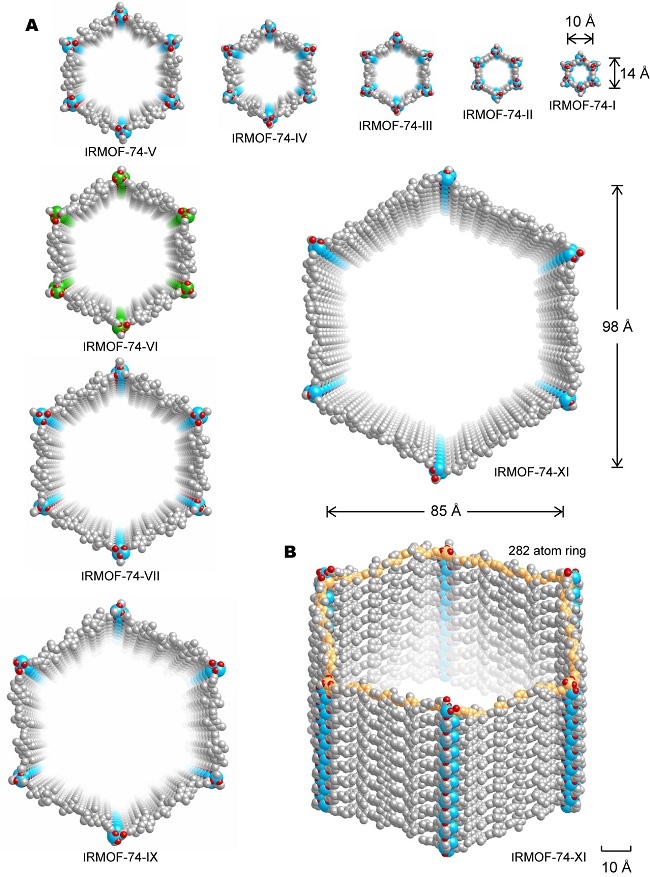
The last decade has seen explosive growth in the synthesis and characterization of porous metal organic framework (MOF) compounds. A major goal has been to maximize MOF porosity and pore size. A key parameter in porosity is the pore aperture, as this controls the size of molecules that might be captured by the pore. Thus far, pore size has been limited to less than 32 Å in diameter, and even in this size regime the structures can collapse. Yet pores of this and larger sizes are highly sought after to enable inclusion of very large molecules, including proteins.
Recently, scientists at the University of California, Berkeley and Lawrence Berkeley National Laboratory have synthesized a series of MOFs with pores large enough to house protein molecules—up to 98 Å—in collaboration with researchers from Northwestern University and international teams including the National Institute of Advanced Industrial Science and Technology (AIST) and JOEL Ltd. of Japan, and Stockholm University in Sweden. In this study, strategies were designed for the first time to overcome three major obstacles to further expansion of the pores: (a) limited solubility of large organic links; (b) structure interpenetration; and (c) collapse of pores after guest molecule removal. In particular, a well-studied MOF with a honeycomb-like pore structure was targeted: MOF-74, which is built from linkers that have one phenylene ring. By expanding the linkers into two, three, four, five, six, seven, nine, and eleven phenylene rings, a series of structures were generated with sequentially larger pores that maintained the same topology of MOF-74.
The crystal structures of these new MOFs were determined by comparing their powder X-ray diffraction patterns with predicted structures generated by computational simulation. Considering that the composition of the inorganic building unit remains unaltered throughout the entire series, the atomic coordinates of the original MOF-74 structure were used to build models for the extended structures. Comparison of the experimental PXRD patterns with those calculated from the crystal models is in good agreement with regard to both positions and the relative intensities of the peaks. Furthermore, the predicted structures are ultimately validated with the Rietveld refinements on PXRD patterns collected at SSRL's Beam Line 2-1 in a reflection geometry. One member of this series, IRMOF-74-IV is shown here as an example (Fig. 1).

These MOF crystals demonstrate remarkable stability, ultrahigh porosity and extremely large pore aperture, leading to a new size regime accessible for the inclusion of large organic, inorganic and biological molecules inside the pores of crystalline materials. Specifically, several members in this series demonstrated that their pores are large enough to allow biomolecules such as myoglobin and green fluorescent proteins (GFPs) to pass through. These new MOFs have potential application in molecular recognition and drug delivery.
Details about this study are available in a recent issue of Science (DOI 10.1126/science.1220131).
The synthesis and characterization of the new MOFs and their properties are publically available and can be found in: http://www.sciencemag.org/content/336/6084/1018.full

H. Deng, S. Grunder, K. Cordova, C. Valente, H. Furukawa, M. Hmadeh, F. Gándara, A. C. Walley, Z. Liu, S. Asahina, H. Kazumori, M. O’Keeffe, O. Terasaki, J. F. Stoddart, and O. M. Yaghi, "Large pore apertures in a series of metal-organic frameworks", Science, 336, 1018-1023 (2012) [doi: 10.1126/science.122013]




